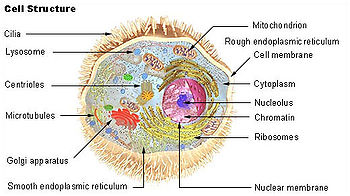Lysosome: Difference between revisions
No edit summary |
m Reverted edits by 24.95.91.127 (HG) |
||
| Line 1: | Line 1: | ||
| ⚫ | |||
'''i luv cheese!!!!!!!!!!!!!!!!! |
|||
| ⚫ | |||
[[image:biological_cell.svg|thumb|350px|Schematic of typical animal cell, showing subcellular components. [[Organelle]]s:<br/> |
[[image:biological_cell.svg|thumb|350px|Schematic of typical animal cell, showing subcellular components. [[Organelle]]s:<br/> |
||
Revision as of 01:44, 13 October 2008


(1) nucleolus
(2) nucleus
(3) ribosomes (little dots)
(4) vesicle
(5) rough endoplasmic reticulum (ER)
(6) Golgi apparatus
(7) Cytoskeleton
(8) smooth endoplasmic reticulum
(9) mitochondria
(10) vacuole
(11) cytoplasm
(12) lysosome
(13) centrioles within centrosome
Lysosomes are organelles that contain digestive enzymes (acid hydrolases). They digest excess or worn-out organelles, food particles, and engulfed viruses or bacteria. The membrane surrounding a lysosome allows the digestive enzymes to work at the 4.5 pH they require. Lysosomes fuse with vacuoles and dispense their enzymes into the vacuoles, digesting their contents. They are created by the addition of hydrolytic enzymes to early endosomes from the Golgi apparatus. The name lysosome derives from the Greek words lysis, which means dissolution or destruction, and soma, which means body. They are frequently nicknamed "suicide-bags" or "suicide-sacs" by cell biologists due to their role in autolysis. Lysosomes were discovered by the Belgian cytologist Christian de Duve in 1949.
At pH 4.8, the interior of the lysosomes is more acidic than the cytosol (pH 7.2). The lysosome's single membrane stabilizes the low pH by pumping in protons (H+) from the cytosol via proton pumps and chloride ion channels. The membrane also protects the cytosol, and therefore the rest of the cell, from the degradative enzymes within the lysosome. For this reason, should a lysosome's acid hydrolases leak into the cytosol, their potential to damage the cell will be reduced, because they will not be at their optimum pH.
Enzymes
Some important enzymes in these are:
- Lipase, which digests lipids
- Carbohydrases, which digest carbohydrates (e.g., sugars)
- Proteases, which digest proteins
- Nucleases, which digest nucleic acids
- phosphoric acid monoesters.
Lysosomal enzymes are synthesized in the cytosol and the endoplasmic reticulum, where they receive a mannose-6-phosphate tag that targets them for the lysosome. Aberrant lysosomal targeting causes inclusion-cell disease, whereby enzymes do not properly reach the lysosome, resulting in accumulation of waste within these organelles.
Functions
The lysosomes are used for the digestion of macromolecules from phagocytosis (ingestion of other dying cells or larger extracellular material), endocytosis (where receptor proteins are recycled from the cell surface), and autophagy (wherein old or unneeded organelles or proteins, or microbes that have invaded the cytoplasm are delivered to the lysosome). Autophagy may also lead to autophagic cell death, a form of programmed self-destruction, or autolysis, of the cell, which means that the cell is digesting itself.
Other functions include digesting foreign bacteria (or other forms of waste) that invade a cell and helping repair damage to the plasma membrane by serving as a membrane patch, sealing the wound. In the past, lysosomes were thought to kill cells that were no longer wanted, such as those in the tails of tadpoles or in the web from the fingers of a 3- to 6-month-old fetus. While lysosomes digest some materials in this process, it is actually accomplished through programmed cell death, called apoptosis.[1][2]
Clinical relevance
There are a number of illnesses that are caused by the malfunction of the lysosomes or one of their digestive proteins, e.g., Tay-Sachs disease, or Pompe's disease. These are caused by a defective or missing digestive protein, which leads to the accumulation of substrates within the cell, impairing metabolism.
In the broad sense, these can be classified as mucopolysaccharidoses, GM2 gangliosidoses, lipid storage disorders, glycoproteinoses, mucolipidoses, or leukodystrophies.
Additional images
-
Proteins in different cellular compartments and structures tagged with green fluorescent protein.
External links
References
- ^ Lysosomes and Peroxisomes
- ^ Mader, Sylvia. (2007). Biology 9th ed. McGraw Hill. New York. ISBN 978-0072464634
 This article incorporates public domain material from Science Primer. NCBI. Archived from the original on 2009-12-08.
This article incorporates public domain material from Science Primer. NCBI. Archived from the original on 2009-12-08.

